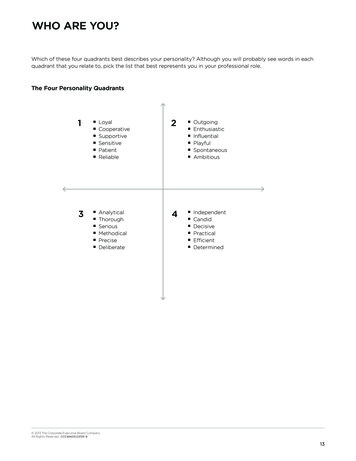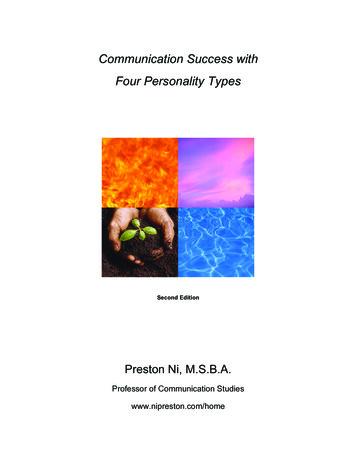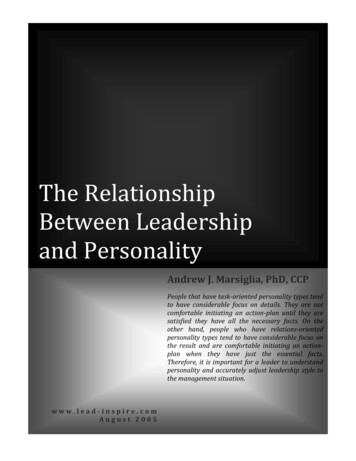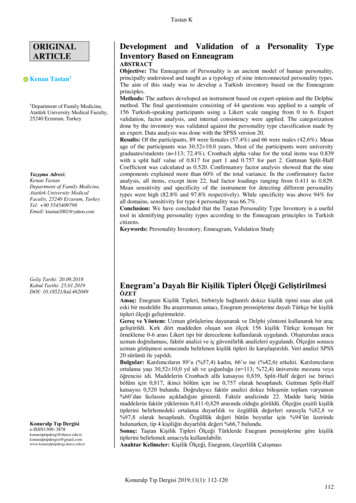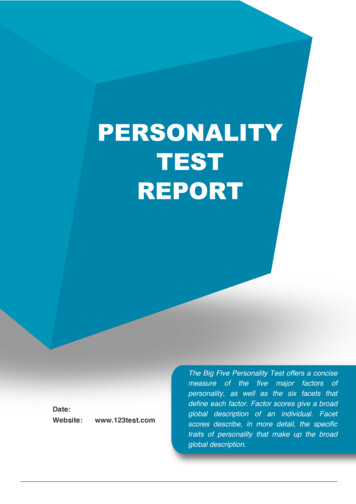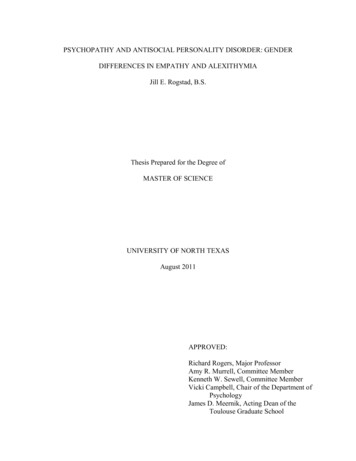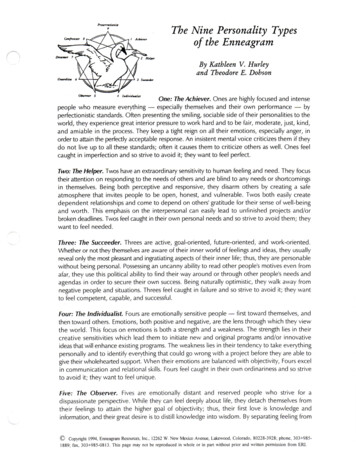
Transcription
PreMTvationittThe Nine Personality Typesof the EnneagramBy Kathleen V. Hurleyand Theodore E. Dobson" "'One: r/je/Ac/j/ever. Ones are highly focused and intensepeople who measure everything — especially themselves and their own performance — byperfectionistic standards. Often presenting the smiling, sociable side of their personalities to theworld, they experience great interior pressure to work hard and to be fair, moderate, just, kind,and amiable in the process. They keep a tight reign on all their emotions, especially anger, inorder to attain the perfectly acceptable response. An insistent mental voice criticizes them if theydo not live up to all these standards; often it causes them to criticize others as well. Ones feelcaught in imperfection and so strive to avoid it; they want to feel perfect.Two: The Helper. Twos have an extraordinary sensitivity to human feeling and need. They focustheir attention on responding to the needs of others and are blind to any needs or shortcomingsin themselves. Being both perceptive and responsive, they disarm others by creating a safeatmosphere that invites people to be open, honest, and vulnerable. Twos both easily createdependent relationships and come to depend on others' gratitude for their sense of well-beingand worth. This emphasis on the interpersonal can easily lead to unfinished projects and/orbroken deadlines. Twos feel caught in their own personal needs and so strive to avoid them; theywant to feel needed.Three: The Succeeder. Threes are active, goal-oriented, future-oriented, and work-oriented.Whether or not they themselves are aware of their inner world of feelings and ideas, they usuallyreveal only the most pleasant and ingratiating aspects of their inner life; thus, they are personablewithout being personal. Possessing an uncanny ability to read other people's motives even fromafar, they use this political ability to find their way around or through other people's needs andagendas in order to secure their own success. Being naturally optimistic, they walk away fromnegative people and situations. Threes feel caught in failure and so strive to avoid it; they wantto feel competent, capable, and successful.Four: The Individualist. Fours are emotionally sensitive people — first toward themselves, andthen toward others. Emotions, both positive and negative, are the lens through which they viewthe world. This focus on emotions is both a strength and a weakness. The strength lies in theircreative sensitivities which lead them to initiate new and original programs and/or innovativeideas that will enhance existing programs. The weakness lies in their tendency to take everythingpersonally and to identif/ everything that could go wrong with a project before they are able togive their wholehearted support. When their emotions are balanced with objectivity, Fours excelin communication and relational skills. Fours feel caught in their own ordinariness and so striveto avoid it; they want to feel unique.Five: The Observer. Fives are emotionally distant and reserved people who strive for adispassionate perspective. While they can feel deeply about life, they detach themselves fromtheir feelings to attain the higher goal of objectivity; thus, their first love is knowledge andinformation, and their great desire is to distill knowledge into wisdom. By separating feeling from Copyright 1994, Enneagram Resources. Inc. 12262 W. N e w Mexico Avenue, L a k e w o o d , C o l o r a d o . 8 0 2 2 8 - 3 9 2 8 ; p h o n e , 3 0 3 9 8 5 -1889; fax, 3 0 3 9 8 5 - 0 8 1 3 . This page may not be reproduced in w h o l e or in part w i t h o u t prior and w r i t t e n permission f r o m E f U .
The Nine Personality Types of the EnneagramHurley and Dobsonfact they pierce to the core of an issue; consequently, their mental acuity is often matched onlyby their tacdessness. They approach life as experts whose dry sense of humor supports them asthey connect with a social wodd in which they feel uncomfortable. Fives feel caught in their ownemptiness and so strive to avoid it; they want to feel full of knowledge.Six: The Guardian. Sixes are responsible people who are driven in their activity by an underlyingsense of anxiety as well as a desire to be included. Often in a sociable and gracious way, theyexpress these needs as desires for personal contact and reassurance. Sixes have deep needs forgroup relationships; thus, family and/or a professional, community, or social group become therecipients of their dedication and loyalty. They are information-oriented people who seemalways to need one more fact, one more view point to feel confident. They are team players whofind independent decision making difficult. Sixes feel caught in personal anxiety and so strive toavoid it; they want to feel secure.Seven: The Dreamer. Sevens are optimistic, happy, and fun-loving idealists who can't admit ofproblems that can't be solved or situations that can't be fixed. These are often mentally creativepeople with overactive minds who have difficulty following through on their plans and ideaswithout the support of others who are more practical. Sevens, who are enthusiasticcommunicators and socially charming, need to balance their idealism with a heavy dose ofrealism, focused effort, and fortitude. Their love for others is most evident in their loyalty andthoughtfulness as they generally avoid any direct communication of intimate emotion. Sevensfeel caught in the pain of life and so strive to avoid it; they want to feel happy.Eight: The Confronter. Eights concentrate on their own abilities to make things happen; thusthey come across as forthright, blunt, firm, and full of life and strength. Some are loud andraucous, others are reserved and proper, but all are direct in communication. They have clearlydefined ideas on what is just and use their considerable strength to make the woHd conform totheir ideas, first for themselves and then for others. Eights are organized people who aredetermined to be in control whenever possible. A tender side lies within them which their ownfamily can tap into, along with anyone they consider to be oppressed. Eights feel caught in theirpersonal weakness and so strive to avoid it; they want to feel strong.Nine: The Preservationist Nines are easygoing, affable people who are professionally andsocially respected, They recoil from conflict of any kind and withdraw into the passive power ofsilence to ward off what they experience as emotional upheaval. Professionally, theseunflappable people prove to be practical, deliberate, and resourceful. They have the resilienceto deal with situations that others find too stressful. Because Nines expend nearly all of theirenergy in the public forum, their private world tends to be neglected both emotionally andphysically. In both worlds, they use silence and affability to get along with others. Nines feelcaught in turmoil and so strive to avoid it; they want to feel peaceful. Copyright 1994, Enneagram Resources. Inc., 12262 \V, N e w Mexico Avenue, Lakewood, C o l o r a d o . 8 0 2 2 8 - 3 9 2 8 ; p h o n e , 3 0 3 9 8 5 -1889; f a x , 3 0 3 9 8 5 - 0 8 1 3 . T h i s page m a y not be reproduced i n w h o l e or in part w i t h o u t prior and w r i t t e n p e r m i s s i o n f r o m E R I .
Farther to Go!ENNEAGRAM 101Joycelyn CampbellAt the simplest level, the Enneagram can be viewed as a personality typing system, butdon't think recognizing and accepting your Enneagram type will strip you of your uniquesense of identity or individuality by lumping you together with every other person of thesame type. Far from being a narrow one-size-fits-all box, each point has plenty of room forsubtleties and variations.Since it doesn't simply pigeonhole people, but is a comprehensive and multifaceted system,it takes a bit of effort to fully grasp. Numerous books are now available on the Enneagram,written from various perspectives. This is a very basic overview of the key elements.Enneagram is a Greek word that means nine points. The Enneagram symbol is composed ofa triangle and a hexad within a circle.954The resulting nine points represent nine basic, or core, personality types, each of which hasa unique perspective and approach to life. The theory behind the Enneagram is that weeach polarize at one of the nine points. We then overdevelop the characteristics associatedwith that point, while leaving the characteristics associated with the other pointsundeveloped. So each point also represents a particular type of imbalance. Our corepersonality type doesn't change over the course of a lifetime, but as we become aware ofour imbalances, we gain the ability to moderate them. We are no longer ruled by them.Several important three-part divisions within the Enneagram underlie its structure.1www.NiMPatl .coM
Farther to Go!CENTERSThe three centers (Doing, Thinking, and Feeling) represent different kinds of intelligenceand are sometimes referred to Centers of Intelligence. Of course we all do things, weall think, and we all feel. But we tend to prefer one type of intelligence over the other two.We all know people who are quick to take action, people who are thoughtful "idea" people,and other people who are emotionally expressive and empathetic.9DOING/C\FEEUNG\G245Each center has a particular issue associated with it, and each of the three types within acenter responds to or deals with that issue in a different way.The Doing center—also referred to the Body or Instinctual center—relates tophysical/material stability and well-being, self-preservation, vitality, action and reaction.Types 8, 9, andl are in the Doing center and share the issue of resistance [anger without afocal point).Is resist internal impulses8s resist the environment9s resist both internal impulses and the environmentThe Feeling center—also referred to as the Heart or Relational center—relates toemotion/feeling, self-gratification, relationship, sexuality, and empathy. Types 2, 3,and 4 are in the Feeling center and share the issue of image [identity without a focal point).2s seek and project an image externally4s seek and project an image internally3s seek and project an image both externally and internallyzwww.NiVvePatKs.com
Farther to QolThe Thinking center—also referred to as the Head or Intellectual center-relates topersonal power, self-definition, logic, rationality, planning, intelligence, and will. Types 5, 6,and 7 are in the Thinking center and share the issue of anxiety [fear without a focal point).5s are anxious about the environment7s are anxious about their inner state6s are anxious about the environment and their inner stateSTANCESAnother grouping of threes, called the stances, represents the basic attitude or approachwe take toward the world and other people. Our stance is most easily understood in termsof our reaction to perceived threats: fight, flight, or submit. The types that share a stancetend to misuse or under-use the same Center of Intelligence [Doing, Thinking, or Feeling),so they have a lot in common with each other.Fight: The Aggressive Stance, also called "moving against" is taken by types 3, 7, and 8, allof whom either misuse or under-use the Feeling center. Aggressive types take the directapproach. They move against what gets in the way of their pursuit of:3s: their goals7s: their satisfaction8s: their agendaSubmit: The Compliant Stance, also called "moving toward" or giving in to others is takenby types 1, 2, and 6, all of whom either misuse or under-use the Thinking center. Complianttypes seek an external point of reference. They move toward what will help them earn:Is: righteousness and autonomy2s: attention and approval6s: safety and securityFlight: The Withdrawing Stance, also called "moving away" or keeping to oneself is takenby types 4, 5, and 9, all of whom either misuse or under-use the Doing center. Withdrawingtypes go inward to find fulfillment. They move away from what triggers a sense of:4s: something lacking5s: personal inadequacy9s: distress and discomfort3vJVJW.Nir Paths.coyv\
Farther to Go!TRIADSEach point on the Enneagram is connected to two other points, so we are actually triadicbeings, and our psyches contain elements of all three types within our triads. T3 e 2, forexample, is actually a 2/5/8. The other triads are 3/6/9 and 1/4/7. Each point within atriad is located in a different center. For the 2/5/8 triad. Type 2 is in the Feeling center.Type 5 is in the Thinking center, and T3 e 8 is in the Doing center. And each point within atriad takes a different stance. Type 2 takes the Compliant stance, Type 5 takes theWithdrawing stance, and Type 8 takes the Aggressive stance. So we have access to all threecenter and all three stances.976V 75 43 (Feeling} / 6 (Thinking) / 9 (Doing)2 (Feeling) / 5 (Thinking) / 8 (Doing)I (Doing) / 4 (Feeling) / 7 (Thinking)We move around within our triad based on the situations we're in and where we are on thecontinuum from asleep-at-the-wheel to awake-and-aware. Learning how to access theother two types [and centers and stances) is the great balancing act of the Enneagram.WINGSIn addition, an Enneagram type may have what is called a wing, which means it is stronglyinfluenced by one of the types directly adjacent to it on either side. A Type 2 could haveeither a 1 wing [represented as 2 w l ) or a 3 wing [represented as 2w3). Or it could be astraight-up Tj e 2 with no wing. Imagine the circle of the Enneagram as a dial you can turnto line up with a stationary arrow. You could line up the dial directly at 2, or you could lineit up several degrees in either direction. The closer you move the dial toward 1, forexample, the more influence Type 1 will have on the 2. The core personality is still 2, butseasoned with a smaller or larger dose of 1.4www.NinePaths.coyv\
Farther to Go!COPING STYLESIn The Wisdom of The Enneagram, Don Richard Riso and Russ Hudson describe what theyrefer to as three Harmonic Groups, which organize the nine types according to their copingstyles.[T]he Harmonic Groups tell us how we cope with conflict and difficulty: how werespond when we do not get what we want. [T]hey reveal the fundamentalway that our personality defends against loss and disappointmentThe Competency Group: Types 1, 3, and 5This group deals with conflict or difficulty by putting aside personal feelings and needs andattempting to solve problems logically and objectively. Each of the three types in theCompetency group has a particular attitude toward playing by the rules.Is naturally tend to play by the rules, and they expect others to do so, too.3s will play by the rules if that works for them, but they're willing to bend the rulesin order to meet their goals or objectives.5s aren't interested in following rules. They don't like being a part of the system, sothey prefer to do things their own way.The Positive Outlool Group: Types 2, 7, and 9This group deals with conflict or difficulty by putting on a pair of rose-colored glasses andthinking positively to reframe disappointment. Each of the three types in the PositiveOutlook group has difficulty giving equal attention to both their needs and the needs ofothers.2s tend to recognize the needs of others and are happy to roll up their sleeves totackle others' problems while pushing their own into the background.7s tend to be more focused on their own needs and often fail to notice the needs(and problems) of others.9s try to pay attention to others' needs, as well as their own, and as a result, theyoften become overwhelmed, so they tend to tune out instead of responding to either.The Reactive Group: Types 4, 6, and 8This group deals with conflict or difficulty by reacting emotionally, and they expect anemotional response in return so they can know where others stand. Each of the three typesin the Reactive Group has issues around trusting other people.swww.NinePathi.com
Farther to Go!4s tend to feel like they're on the outside to begin with and are very sensitive toslights and perceived slights (lack of support). They are easily hurt.6s want to be seen as strong and reliable, but at the same time, they want to feelsupported by others. They can get defensive.8s are comfortable in the supportive role, but they don't want to need other people,so they keep their guard up to prevent others from getting too close. They are easilyangered.Coping styles provide a lot of insight into interpersonal conflicts. It helps to know whatyour own tendency is and then to try to understand the other person's. No coping style isbetter than the others, and none is effective in all conflict situations. It would be nice tohave the full repertoire to choose from each time a conflict arises. But our coping styledevelops from various aspects of our basic type, and just as our type won't change overtime, neither will our fallback response to conflict. By paying attention to that response,however, we can gain at least a little distance from it. We can learn to be less at the effect ofit. We can have an awake moment instead of continuing to cruise along on autopilot.Enneagram type certainly isn't the only factor that determines what we do, think, and feel.Our own life experiences, among other things, influence how we see the world and how weunderstand and relate to it. But the Enneagram provides a clear and powerful lens into theworkings of our psyches. It doesn't stop there, however. It actually shows us a way out ofour personal gridlock. While it isn't magic and won't take us anywhere all by itself, it laysout a roadmap with a starting point and some targets to aim for. It hands us a compass andsends us off to explore and get to know ourselves and to expand our horizons.Since all of us live with, love, and are connected to many other people, it's important to gainan understanding of all the types, not just our own. Unlike many other typology systems,the Enneagram takes account of both the parts (each of us)—which are represented by thepoints—and the whole (all of us)—which is represented by the circle. It helps usunderstand the ways in which we are similar to each other, as well as the ways in which wediffer.6www.Niy\ Paths.C0M
Farther to Go!WHAT DRIVES US?Brief Sketches of What IVlotivates the 9 Enneagram TypesIs are compliant to their idealistic obligations, moving toward what will help them earnrighteousness and resisting the inner impulses that might lead them astray. To keep theirangry impulses out of their awareness, they do the opposite of what they are inclined to do(instead of confronting someone, being nice to him or her; instead of being sexual,becoming puritanical). They tend to be concerned with what is right in front of them(subject, as are the other two Compliant types, to what has been called "the tyranny of theimmediate moment"). They tend to play by the rules and expect others to do so, too. Theywant to be right, to have integrity and balance, to strive higher and improve others, to beconsistent with their ideals, to justify themselves, to be beyond criticism so as not to becondemned by anyone. Type 1 is called The Good Person, The Achiever, The Reformer, andThe Perfectionist.Kejnvord: Principle2 s are compliant to their need to be seen as friendly and helpful by others, so they movetoward what will help them earn attention and approval. They tend to be concerned withwhat is right in front of them (subject, as are the other two Compliant types, to what hasbeen called "the tyranny of the immediate moment"). They tend to recognize the needs ofothers and are happy to roll up their sleeves to tackle others' problems while pushing theirown into the background. Because their own needs make them anxious, they keep them outof their awareness by repressing them. They project their needs onto others (so otherpeople are needy, but they aren't). They want to be loved, to express their feelings for others,to be needed and appreciated, to get others to respond to them, to vindicate their claimsabout themselves. Type 2 is called The Helper, The Giver, The People Pleaser, and ThePartner.Keyword: Persuasion3 s aggressively attempt to maintain both an inner and an outer image of success, movingagainst anything that prevents them from attaining their goals. To keep failure out of theirawareness, they identify with whatever successful mask or role they are playing at thetime. They identify with their roles instead of with themselves. Like the other Aggressivetypes, they tend to hurry through the present and not give much thought to the past Theywill play by the rules if that works for them, but they're willing to bend the rules in order tomeet their goals or objectives. They want to feel valuable and worthwhile, to be affirmed, todistinguish themselves, to have attention, to be admired, and to impress others. Type 3 iscalled The Performer, The Succeeder, The Motivator, and the Status Seeker.Keyword: Performance1www.NinePaths.com
Farther to Go!4s withdraw in order to nurture an internal image of uniqueness, moving away fromanything that triggers a sense of something lacking. In order to avoid experiencing thecommon and ordinary, whenever anything seems bland they turn it into somethingextraordinary or dramatic. Like the other Withdrawing types, they tend to focus on thepast, often feeling victimized by i t They tend to feel like they're on the outside to beginwith and are very sensitive to slights and perceived slights (lack of support). They areeasily hurt. They want to be themselves, to express themselves in something beautiful, to fmdthe ideal partner, to withdraw to protect their feelings, to take care of emotional needs beforeattending to anything else. Type 4 is called The Individualist, The Tragic Romantic, TheArtist, and The Sensitive Person.Keyword; Passion5s doubt their ability to deal effectively with the external world, so they withdraw intotheir own minds to avoid coming in contact with anj hing that might make them feelinadequate. To avoid feeling empty, they isolate themselves in their heads away from theirfeelings and other people. They focus on their thoughts in order to make themselves feelfull and comfortable. They also isolate or compartmentalize one time period—or aspect—of life from another. Like the other Withdrawing types, they tend to focus on the past andoften reflect on their prior experiences. They aren't interested in following rules. Theydon't like being a part of the system, so they prefer to do things their own way. They wantto be capable and competent, to master a body of knowledge and skill, to explore reality, toremain undisturbed by others, to reduce their needs. Type 5 is called The Observer, TheInvestigator, The Knowledge-Seeker, and The Thinker.Keyword: PrivacyBecause they are anxious about their inner worlds and the external world, 6s move towardwhatever—and whomever—they believe will make them feel safe and secure. 6s are themost anxious of the three Thinking center types. They project onto others their own senseof disobedience and rebellion. Other people are trying to get away with things, and 6s needto monitor their activities and bring them in line with their authority's principles. Or othersare trying to trip them up and trap them. They tend to be concerned with what is right infront of them (subject, as are the other two Compliant types, to what has been called "thetyranny of the immediate moment"). They want to be seen as strong and reliable, but at thesame time they want to feel supported by others. They can get defensive. They want to havesecurity, to feel supported, to have the approval of others, to test the attitudes of otherstoward them, to defend their beliefs. Type 6 is called The Loyalist, The Questioner, TheGuardian, and The Devil's Advocate.Keyword: Participationwww.NinePaths.com
Fartlr\er to Go!7s want to avoid experiencing the pain that could result from their own thoughts andfeelings, so they aggressively move against whatever gets in the way of their happiness andcontentment by focusing on external events and activities. To keep pain out of theirawareness, they sublimate it and turn it into something interesting or good. Theyautomatically look for the good in everything. So they might celebrate the new life of adeceased loved one rather than mourn their loss. Like the other Aggressive types, they tendto hurry through the present as they make plans for the future. They tend to be morefocused on their own needs and often fail to notice the needs (and problems) of others.They want to be happy and satisfied, to have a wide variety of experiences, to iceep theiroptions open, to enjoy life and amuse themselves, to escape anxiety. Type 7 is called TheAdventurer, The Epicure, The Generalist, and The Enthusiast.Keyword: Pleasure8s aggressively assert themselves against others and the environment, moving againstwhat gets in the way of their pursuit of their agendas. To prevent weakness from showingup in their awareness or persona, they deny any presence of it (the real kings and queens ofdenial). Like the other Aggressive types, they tend to hurry through the present and notgive much thought to the past. They are comfortable in the supportive role, but they don'twant to need other people, so they keep their guard up to prevent others from getting tooclose. They are easily angered. They want to be self-reliant, to resist their weakness, to havean impact on the environment, to assert themselves, to stay in control, to prevail over others,to be invincible. Type 8 is called The Challenger, The Confronter, The Leader, the Asserter(and a few other things that are unprintable).Keyword: Power9s withdraw so others won't disturb their inner peacefulness, moving away from anythingthat triggers a sense of distress and discomfort, whether it's internal or external. To avoidconflict, they numb their feelings, wants, and preferences. They make everything the sameand highlight nothing. They make molehills out of mountains. Like the other Withdrawingtypes, they are focused on the past and tend to ruminate about what happened, both goodand bad. They try to pay attention to others' needs as well as their own; as a result, theyoften become overwhelmed so they tune out instead of responding to either. They want tohave serenity and peace of mind, to create harmony in their environment, to preserve thingsas they are, to avoid conflicts and tension, to escape upsetting problems and demands onthem. Type 9 is called The Peacemaker, The Preservationist, The Mediator, and theUniversalist.Keyword: PeaceFor more information, check out www.NlnePaths.comand search by type number (Type 1, e.g.) to find more information on each type.3www.NinePatl .com
Nov 03, 2015 · The types that share a stance tend to misuse or under-use the same Center of Intelligence [Doing, Thinking, or Feeling), so they have a lot in common with each other. Fight: The Aggressive Stance, also called "moving against" is taken by types 3, 7, and 8, all of whom either misuse or under-use the Feeling
